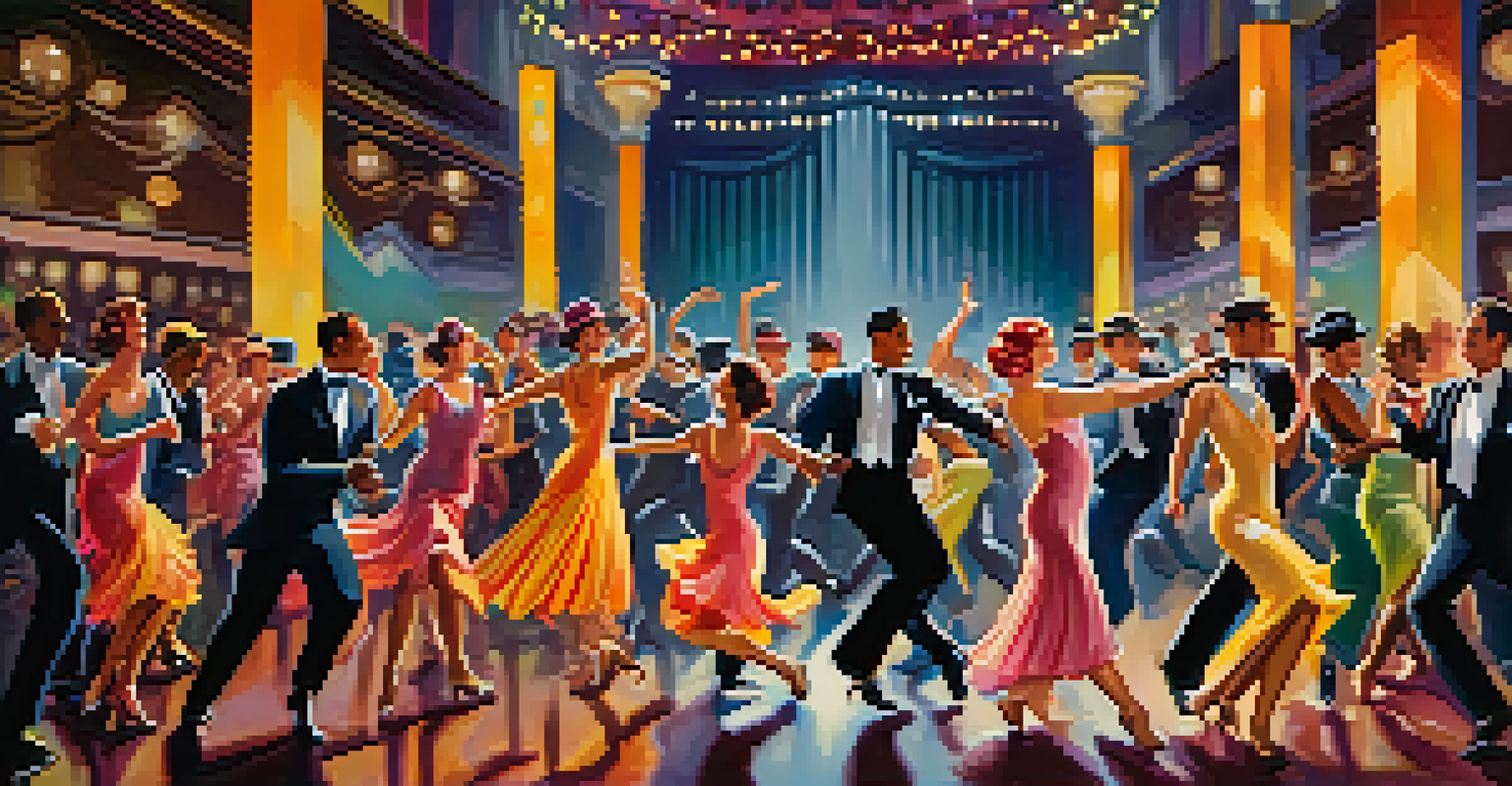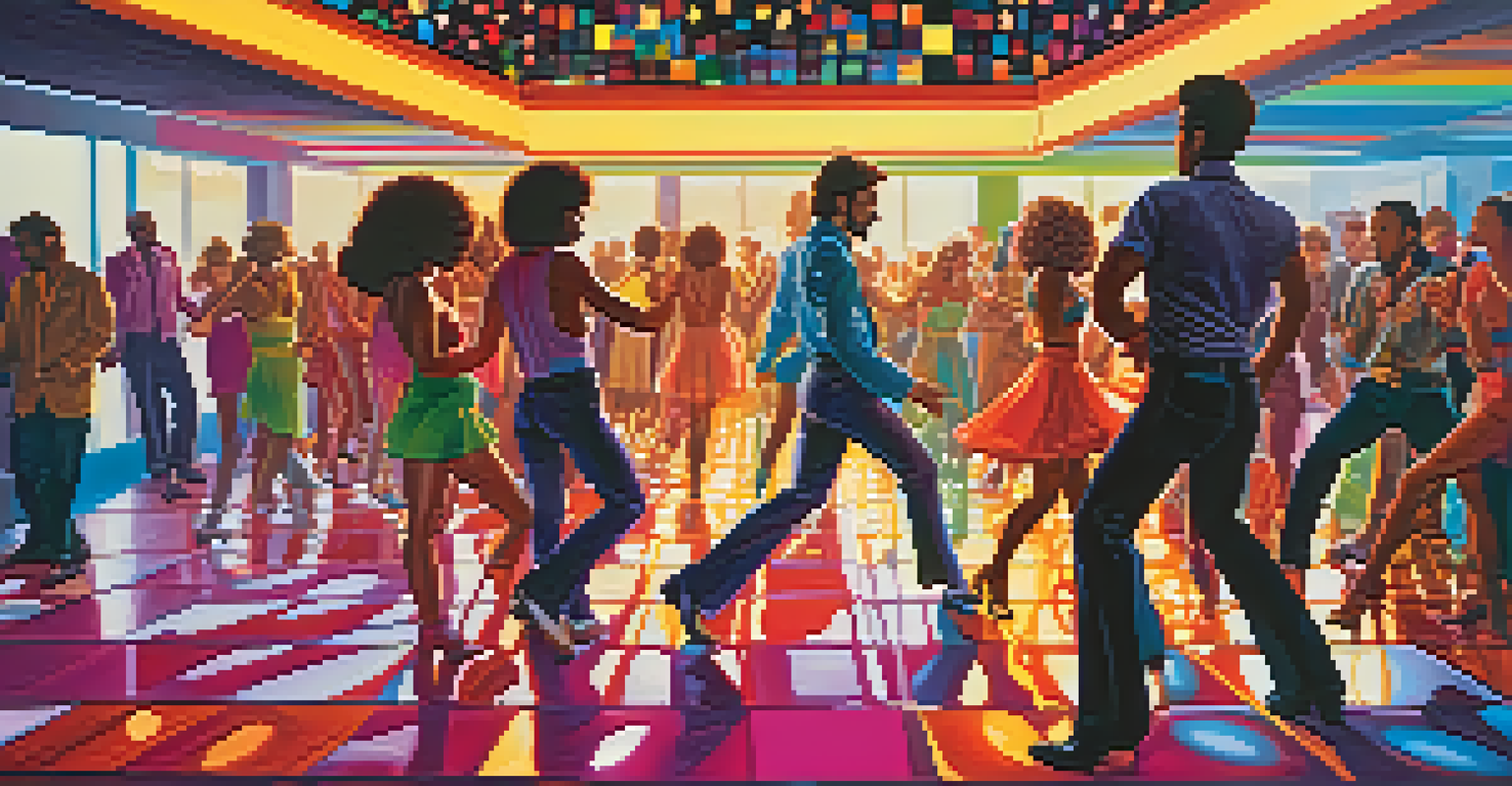From Waltz to Hip Hop: Evolution of Dance Through Music

The Waltz: A Dance of Grace and Elegance
The waltz, originating in the late 18th century, is a perfect example of the elegance of ballroom dancing. Characterized by its smooth, flowing movements, it invites couples to glide across the floor in a rhythmic 3/4 time. As it gained popularity, the waltz became a staple at social gatherings and balls, symbolizing romance and sophistication.
Dance is the hidden language of the soul.
Its influence extended beyond just dance; the waltz also shaped music composition, inspiring composers like Johann Strauss. The music's soft, lilting melodies complemented the dance's graceful movements, creating a harmonious experience for both dancers and spectators. This synergy between dance and music laid the groundwork for future styles.
As the waltz evolved, it began to incorporate variations and adaptations, paving the way for other dance forms. It offered a glimpse into how music could inspire movement, setting the stage for the diverse dance genres that would follow.
The Rise of Jazz: Dance Meets Rhythm
With the emergence of jazz in the early 20th century, dance experienced a thrilling transformation. Jazz music, with its upbeat tempo and syncopated rhythms, encouraged dancers to express themselves in new and dynamic ways. Styles like the Charleston and the Lindy Hop became wildly popular, showcasing energetic footwork and improvisation.

Dancers began to break free from the structured movements of the waltz, embracing the spontaneity that jazz offered. This shift not only changed the way people danced but also influenced social dynamics, as African American culture and music played a crucial role in shaping the dance scene. The jazz age was a celebration of freedom, self-expression, and creativity.
Dance Reflects Cultural Evolution
The evolution of dance styles, from the waltz to hip hop, showcases how music and social movements intertwine with cultural identity.
The blend of jazz music and dance styles created a cultural phenomenon that resonated across the globe. It marked a significant turning point, illustrating how music could inspire a wide array of dance forms, each with its own unique flair.
The Birth of Rock 'n' Roll: A Cultural Revolution
The 1950s ushered in the era of rock 'n' roll, igniting a cultural revolution that transformed dance once again. With its infectious beats and rebellious spirit, rock 'n' roll encouraged new styles like the Twist and the Jitterbug. These dances reflected the energetic and youthful vibe of the music, allowing everyone to join in the fun.
Music can change the world because it can change people.
As rock 'n' roll gained popularity, it became a symbol of freedom and rebellion, particularly among teenagers. Dance floors filled with lively movements, representing a break from traditional forms and an embrace of individuality. This shift highlighted how music and dance could serve as expressions of cultural identity and social change.
The rock 'n' roll phenomenon also paved the way for the evolution of dance in popular culture. It set the stage for the integration of music and dance in television and movies, making dance an essential element of entertainment.
Disco Fever: Dance in the Spotlight
The 1970s introduced disco, a genre that combined funk, soul, and pop, creating a new dance culture that thrived in nightclubs. With its pulsating beats and catchy melodies, disco encouraged dancers to showcase their moves on the dance floor, often featuring elaborate attire and vibrant lights. The hustle and the bump became iconic dances of the era, emphasizing fun and community.
Disco's influence extended beyond just music and dance; it also shaped fashion, nightlife, and social interactions. The disco scene was a melting pot of diverse cultures, bringing people together to celebrate life through movement. This collective experience deepened the connection between dance and music, as both became synonymous with liberation and joy.
Technology Shapes Dance Today
Advancements in technology have transformed dance by enabling global sharing, fostering new trends, and encouraging creative expression.
As disco fever swept the world, it highlighted the importance of dance in social settings, reinforcing the idea that dance could not only entertain but also unite people. This era set the foundation for future dance trends that would continue to evolve with the changing music landscape.
Hip Hop: A Cultural Movement Through Dance
Emerging from the streets of the Bronx in the late 1970s, hip hop dance represented a powerful cultural movement. With its roots in African American and Latino communities, hip hop embraced creativity, self-expression, and storytelling through movement. Styles like breaking, locking, and popping became symbols of individuality and artistic freedom.
Hip hop's connection to music is undeniable, as it often incorporates the rhythms and beats of rap and DJing. The movement's emphasis on improvisation and freestyle dancing allows for personal expression, making it a dynamic and ever-evolving art form. This fluidity reflects how hip hop music and dance are intrinsically linked, each influencing the other.
As hip hop gained mainstream popularity, it transcended cultural boundaries and influenced dance worldwide. It encouraged a generation to embrace their unique styles and backgrounds, demonstrating that dance could be a form of empowerment and social commentary.
The Influence of Technology on Dance Evolution
In the digital age, technology has played a crucial role in the evolution of dance. From music videos to social media platforms like TikTok, technology allows dancers to showcase their talents and connect with audiences globally. This accessibility has given rise to new dance trends and challenges, making dance more inclusive and diverse than ever before.
Moreover, advancements in music production have changed the way genres are created, leading to hybrid styles that blend elements from various influences. This fusion has inspired dancers to innovate and experiment with their movements, reflecting the dynamic nature of contemporary music. The interplay between technology and dance continues to reshape how we perceive both art forms.
Future of Dance is Diverse Fusion
The future of dance promises a rich blend of styles and cultures, highlighting its role as a universal language for human expression.
As technology advances, so does the relationship between dance and music, creating opportunities for collaboration and creativity. It encourages dancers to explore new avenues of expression, ensuring that the evolution of dance remains vibrant and relevant.
The Future of Dance: A Blend of Styles and Cultures
Looking ahead, the future of dance appears to be a blend of various styles and cultures, showcasing the rich tapestry of human expression. As globalization continues to connect societies, dancers are increasingly influenced by a myriad of genres, creating unique fusions that reflect their diverse backgrounds. This evolution emphasizes the idea that dance is a universal language.
Furthermore, the rise of dance competitions and reality shows has popularized dance forms and inspired new generations to participate. As young dancers embrace these influences, they contribute to an ever-evolving landscape that celebrates creativity and collaboration. This dynamic environment ensures that dance remains a vital part of cultural expression.

Ultimately, the future of dance will likely mirror the vibrancy of the music that inspires it. With each new genre and trend, dance will continue to evolve, reminding us that it is not just a performance but a celebration of life, culture, and community.